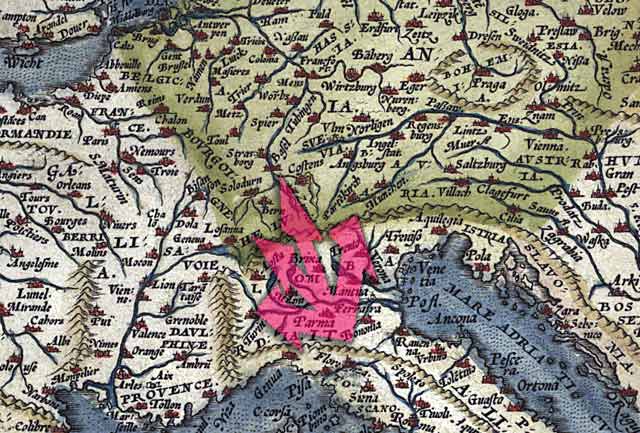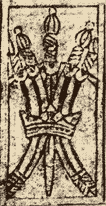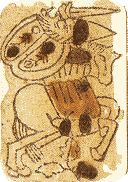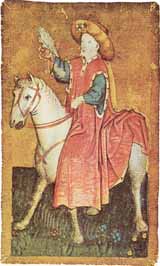Playing cards in the Upper Rhine region
Documentary evidence suggests that card playing established itself in Italy in 1376, and then spread rapidly northwards across the Alps into the Upper Rhine regions of Germany and Switzerland and westwards into France and Spain.
Playing cards in the Upper Rhine region
 |
||||
Documentary evidence suggests that card playing established itself in Italy in 1376, and then spread rapidly northwards across the Alps into the Upper Rhine regions of Germany and Switzerland and westwards into France and Spain, as suggested by the pink arrows on the above map. In 1377, the Dominican monk Johannes von Rheinfelden from Basle wrote an allegory on the pack of cards in which he described packs containing queens, or two kings and two queens each with their 'marschalli', or packs with four, five or six kings each (i.e. 4, 5 or 6 suits), and so on… North of the Alps, the Upper Rhine emerged as an important area for early playing card manufacture. A major economic factor was the city of Basle, a significant commercial centre situated on the transit route between Italy and the Rhine valley. Many of the extant early painted and engraved playing cards originated here. |
Factors facilitating the dissemination of card playing include the emergence of an urban mercantile class whose trading activities necessitated fast transport routes; the existence of cheap raw materials for printing in the form of paper; and finally the technique of reproducing the images by means of wood carving. See also: The Stuttgart Playing Cards | The Ambras Court Hunting Deck | The Master of the Playing Cards | Early German Engraved Cards | Hofämterspiel, c.1460 | XV century Spanish cards | XV century Italian cards | Spanish-suited cards made in Germany | Early French cards | XVI century Swiss cards.
|
|||

By Simon Wintle
Member since February 01, 1996
I am the founder of The World of Playing Cards (est. 1996), a website dedicated to the history, artistry and cultural significance of playing cards and tarot. Over the years I have researched various areas of the subject, acquired and traded collections and contributed as a committee member of the IPCS and graphics editor of The Playing-Card journal. Having lived in Chile, England, Wales, and now Spain, these experiences have shaped my work and passion for playing cards. Amongst my achievements is producing a limited-edition replica of a 17th-century English pack using woodblocks and stencils—a labour of love. Today, the World of Playing Cards is a global collaborative project, with my son Adam serving as the technical driving force behind its development. His innovative efforts have helped shape the site into the thriving hub it is today. You are warmly invited to become a contributor and share your enthusiasm.
Related Articles

Modern Swiss-German Pattern (carta.media)
Modernizing tradition: balancing clarity and continuity in regional card design.

Late flowering of the Lyon pattern
Faustino Solesio’s late version of the Lyon pattern from about 1870.

CARD-AB Miltenberg
Illustrations by Rita Stern depicting notable landmarks and scenes from the town of Miltenberg in Ge...

Czech National Patterns by S.D. Modiano
Modiano produced cards with the Prague and Trappola patterns in the early 20th century.

New Altenburg Skat cards – German DDR Pattern
Authentic Altenburger Skat cards with German suits (Acorns, Hearts, Leaves, Bells).

Emilio Tadini playing cards
Beautiful dreamlike playing card designs by Emilio Tadini.

German Travel Cards
A travel-themed educational deck helping American tourists visiting Germany.

French Revolutionary cards by Pinaut
Seven cards from a French Revolutionary pack by Pinaut featuring characters from classical antiquity...

Zürcher Festspiel 1903
Swiss-suited pack designed by Robert Hardmeyer featuring figures from art and politics.

Austrian Tarock by S.D. Modiano
Modiano’s Austrian Tarock with country scenes has been in production for over 100 years.

Briefmarken-Quartett
Quartet game featuring postage stamps from the Zones of Occupation in post-WWII Germany.

Le carte da gioco Arcimboldo
Courts and suit-signs inspired by the works of the Italian Renaissance painter, Giuseppe Arcimboldo....

22 Pittori in 22 Arcani
Collaborative Tarot with contributions from 22 different Italian artists including Menegazzi and Tav...

IG Chemie Papier Keramik
Promotional pack designed by Karl-Heinz Schroers for a German trade union with comical bears on the ...

Justice playing cards
Ethical concepts in a deck produced by Riccardo Conturbia’s Passione Playing Cards Ltd.

Alan Tarot Deck
Reprint of a Tarock pack originally designed by Argio Orell for the Austrian Lloyd shipping company....
Most Popular
Our top articles from the past 28 days




